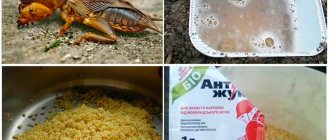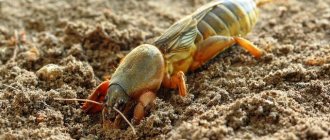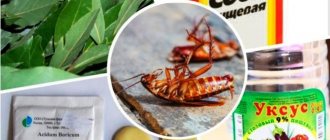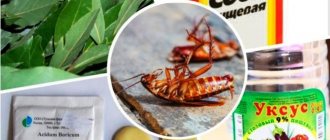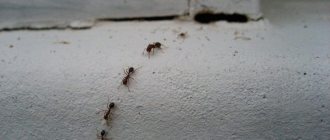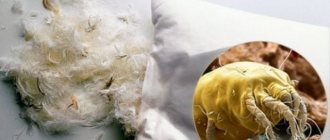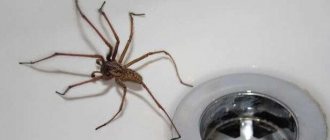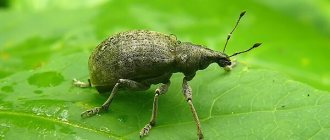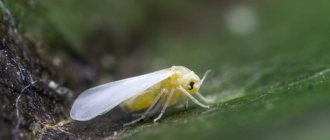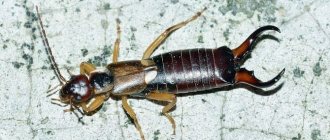Wireworms are the larvae of all pests that belong to the genus of click beetles (Elateridae). In appearance, they are worms, sometimes reaching 45 mm in length, with powerful nodules and a body as hard as wire.
Stages of development:
- May-July: beetles (imago) lay eggs (1st stage).
- After 20 days, larvae appear from the laid eggs (stage 2 lasts from 2 to 5 years).
- After at least 24 months of life (July-August), the larva becomes a pupa (3rd stage - 14-21 days).
- August-September: the pupa turns into a beetle and overwinters in a cradle.
- From April next year, the beetles migrate, looking for conditions favorable for reproduction.
The larvae live in the top layer of soil (found at a depth of up to 15 cm), and before autumn frosts they burrow to a depth of up to 60 cm.
How dangerous are these larvae?
Many believe that the favorite delicacy of these worms is new potatoes. But wireworms do not disdain any parts of the plant: the root system, the lower parts of the stems, fruits, seeds. They can also switch to root vegetables such as carrots, rutabaga, beets, turnips, radishes, etc.
In their absence, they can settle in the juicy roots of cabbage, tomatoes, eggplants, onions, peppers and other vegetable crops, and the bulbs of decorative flowers (lilies, peonies, gladioli). Plants begin to wither, fruits lag behind in growth, lose their presentation, and are poorly stored.
The main signs of the appearance of wireworms on plants are:
- wilting or sudden yellowing of plantings, often individual bushes, and not all specimens in a row;
- causeless drying of mature plants, which are easily removed from the ground;
- leaf lethargy;
- noticeable growth retardation.
If you remove the root crops, you can easily notice dark winding passages in them, dots from pests, and sometimes even the culprits of the damage themselves.
How to prevent it from appearing on a potato plot
To prevent the problem, you should adhere to the following recommendations:
- Do not allow the soil to become sour and overgrown with weeds, especially wheatgrass.
- Plant plants that repel click beetles next to potatoes - legumes, marigold flowers, mustard, spinach, oilseed radish.
- Maintain crop rotation, since potatoes, which grow in one place for several years in a row, deplete the soil, depriving it of nutritional components.
- Carefully loosen the soil in May and early summer so that beetle eggs fall on the soil surface and die under the influence of light.
Brief description of the pest
The adult individual (click beetle) is small in size, reaching only 1.5-2 cm in length. Its distinctive feature is that the insect is capable of making a characteristic click when turning over. During the summer, the female is capable of laying an average of 100-150 eggs in the soil, from which the larvae of the harmful wireworm emerge.
2-4 year old worms are characterized by a segmented body with numerous legs. Their length can vary up to 2-3 cm, and adult specimens have a hard shell of chitin, which does not allow them to simply be crushed by hand.
If you look at a photo of a wireworm, you can see that in appearance they resemble small pieces of wire (which is why they got that name).
Signs of a wireworm attack on potatoes
Recognizing the presence of an insect on a site is quite simple. If a wireworm eats a potato, several symptoms indicate that the plantings are infested:
- among healthy potato bushes, from time to time there are wilted diseased plants; the wireworm does not migrate well in the horizontal direction, so it very rarely affects entire rows of potatoes;
- on tubers dug out of the ground, numerous dark depressions and narrow through passages are noticeable; these are the holes that the pest gnaws;
- large dark beetles with an elongated body are found in the upper layer of soil during loosening and other garden work - during the active period, adult pests live close to the surface of the earth, 5-10 cm.
Important! An adult wireworm can be confused with a ground beetle, but it is easy to distinguish it by the clicking sound that the harmful insect makes when it tries to roll over from its back to its feet.
Life cycle of individuals
The larvae themselves overwinter in the ground at a depth of about half a meter, although the beetles are able to burrow only to 20-30 cm. The pupation process occurs in August, for this purpose depressions are made in the ground. Young beetles emerge from the pupae and remain to overwinter in the ground. In the spring they fly out and begin to lay eggs, from which after 2-3 weeks small wireworms appear, which at first do not pose any particular danger.
In the first year, the worms grow only 5-6 mm and crawl into the soil to spend the winter. On average, larvae live in appropriate conditions from 2 to 5 years. Therefore, when they appear, you will have to use some kind of wireworm remedy to kill this malicious pest.
How to get rid of it?
How to get rid of (fight) wireworms in the ground? Having found at least one individual of the dartweed in the garden, you immediately need to make efforts to destroy it , because it certainly will not climb without its fellows.
Help: One click beetle lays eggs in the ground, from which at least 150 larvae .
Drotyanka - the fight against it must be comprehensive. Let's consider the main control methods that are effective both in a potato field and on unplanted land:
- leguminous crops on a suburban area that are considered unacceptable for dartweed: peas, beans, chickpeas, beans and soybeans;
- in places where this pest is most concentrated, it is recommended to sow mustard, clover, alfalfa, spring rape or buckwheat;
- manually carefully select the roots of wheatgrass, thistle and cock millet from the soil;
- do not plant the soil too thickly . If the area is small and you need to plant a lot of things, often weed the rows, which will loosen the soil and rid it of weeds;
- after weeding is completed, do not leave weeds , roots or their old tops;
- try to make the soil less acidic . To do this, when planting vegetables, pour ash, crushed eggshells, lime and chalk into the furrows;
- marigolds between potatoes, onions and carrots , which during their flowering emit an unpleasant odor for the larvae of the click beetle, repelling them;
- in mid-autumn (October), dig up the garden deeply by hand. Important! The depth should not be less than 20 cm , which will allow the wireworm to be lifted from the ground and turned over to the surface. Cold ground will cause it to freeze;
- at the end of spring or early summer loosen the ground , which will allow the eggs of the click beetle to be raised to the surface of the soil. Under the influence of the bright and hot sun they will die.
In addition, it should be said about two existing measures to combat drotyanka , which have an equally positive effect on the condition of the soil:
- chemical – aimed at introducing chemicals into the soil that can destroy wireworms;
- agrotechnical - the meaning of this method is that the land is enriched with nitrogen fertilizers containing ammonium. You can also use regular ammonia water, which is sprinkled on the garden.
Immediately after treating the soil in this way, the soil must be carefully dug up so that ammonia does not evaporate .
We will look at how to deal with wireworms in the following paragraphs.
Our articles will tell you about pests and how to combat them. Read about thrips, cicadas, aphids, slugs, locusts, moths, nematodes, mice, woodlice, moles.
Basic methods of struggle
Based on information about the full life cycle and behavioral characteristics, experts have developed several effective methods of combating the parasite:
- Creating unfavorable living conditions for the wireworm (since the worm loves acidic soil, use liming with chalk or dolomite flour, adding ash, eggshells; use mineral fertilizers containing chlorine, ammonium nitrate, the smell of which can repel these pests).
- The use of chemicals and insecticides such as Karate, Kapkan, Bazudin, Decis, Grom-2, Zemlin, Provotox, Prestige, Terradox, Commander, Aktara, etc. (they treat planting material, holes, grooves strictly according to the instructions). Granules of Zarit, Pochin, Rubita, Barguzin are very convenient for embedding into the ground.
- The use of biological products based on special pathogenic nematodes that feed on these larvae, among which the most famous are Etonem-F, Metarizin and Nemabact.
Don’t forget about folk remedies that are quite effective in treating wireworms, such as preparing herbal “poisons” from nettle, coltsfoot, dandelion, celandine, and onion peels. Good results are obtained by watering the holes with a solution of potassium permanganate (2-4 g per bucket of water), and using mustard powder.
Some lovers of natural methods use spruce or pine branches buried in the soil, since this type of garden pest does not like the pungent smell of pine needles.
Fighting wireworms in the garden
How to deal with wireworm
If other insects can be easily dealt with with the help of insecticidal or acaricidal preparations, then when fighting wireworms, you will have to tinker. How to destroy wireworm? The wireworm lives in the soil and is not easy to get to. The fight against wireworms on the site should be carried out using all possible measures in a complex, that is, using agrotechnical, mechanical and chemical methods.
- Tinder fungi on walnuts - why they are dangerous and how to get rid of harmful mushrooms
Agrotechnical measures against wireworms include:
- deep spring digging of the soil with thorough destruction of larvae, pupae and click beetles, as well as weeds, in particular, wheatgrass and fireweed rhizomes;
- compliance with crop rotation. For example, planting potatoes versus beans and peas;
- sowing green manure that repel wireworms. Effective green manures against wireworms are mustard, lupine, vetch or alfalfa;
- sowing potato lettuce in rows, the roots of which are eaten by wireworms;
- deep autumn digging or moldboard plowing of the soil before the first frost, which allows reducing the number of wireworms by 50-90%.
Remedies and preparations for wireworms
The wireworm's appetite can be spoiled by placing 3-4 superphosphate granules in each hole, treated with an insecticide. For treatment, wireworm preparations such as Actellik, Karate or Decis are used. Superphosphate is scattered in a thin layer and the granules are sprayed with a solution prepared according to the following recipe: Actellik (or other insecticide) - 15 ml, water - 80 ml, acetone - 200 ml.
When the number of wireworms cannot be controlled by any other means, one has to resort to the use of the highly toxic drug Bazudin or Diazinon, which is slightly less dangerous for warm-blooded animals. The drug Prestige for wireworms and Colorado potato beetles also reduces the number of pests by more than half, and it is not as harmful as Bazudin. Provotox from wireworms is not addictive to the pest, has low toxicity to humans, is harmless to earthworms and has a long shelf life.
In addition to the listed chemicals, wireworm control agents such as Grom-2, Kapkan, Zemlin, Aktara, Force, Metarizin and Dohlox are used. But no matter what insecticide you choose, it can only be used in strict accordance with the instructions.
A little about repellent plants
If a gardener is faced with the question of how to deal with wireworms, it is worth remembering some secrets. For example, they do not like the smells of such plants:
- green manure, especially mustard, lupine, phacelia, rapeseed, alfalfa, rapeseed, sweet clover, buckwheat;
- some legumes, such as beans, peas, vetch, beans, planted between rows in the affected area;
- Among flower crops, dahlias and marigolds are not favored.
You should not sow rye and other cereals nearby, because adult insects like to feed on the leaves of plants of these families. The roots of wheatgrass, sedge, and millet are also considered a favorite delicacy of worms, with which they will have to wage a merciless fight.
Preventative treatment
To get rid of wireworms forever, you need not only to destroy them, but also to carry out preventive measures every year that will no longer allow them to appear on your site. Such events include:
- Bitoxibacillin - summer treatment of garden pests with a biological product
- change the place for growing crops at least once every 2-3 years;
- Carrying out annual spring and especially autumn digging of the site to the depth of a spade bayonet. The larvae raised from the depths of the soil during autumn digging will die from the cold in winter, and spring tillage will clear the soil of the roots of weeds on which wireworms feed;
- loosening the soil in the area in May-June, so that the eggs of the click beetle fall to the surface, where they die from the sun's rays;
- regular weeding of the area, carried out to cleanse the soil of wheatgrass and other weeds. If the weed situation is critical, use Roundup to kill it;
- keep the area clean, remove grass and tops in the fall, in which the wireworm likes to spend the winter comfortably;
- To repel click beetles, you can grow marigolds, the aroma of which attracts pests, despite the fact that the juice of these plants is poison for them. Wireworms in the garden are afraid of legumes (black beans, soybeans, peas and beans), because bacteria that produce nitrogen live in their roots. To enhance the effect, you can sow phacelia together with legumes, which neutralizes acidic soil;
- The wireworm on the site does not like plants such as mustard, rapeseed, buckwheat, spinach, sweet clover, rapeseed and oilseed radish, so once every 2-3 years, in line with potatoes or root crops that the wireworm feeds on, you need to sow one of the listed crops In this case, the larvae will either die or, turning into beetles, will leave the area;
- those who have used rye against wireworms claim that it not only does not repel pests, but, on the contrary, attracts them. In addition, this crop takes too much moisture from the soil, so it is better to grow other plants as green manure;
- A very effective way to combat wireworms is to treat the surface of the area with table salt once every seven years (not more often).
Well, some advice for those who have just started cultivating a plot of land: there are a lot of wireworms in the virgin soil, so in the first years, until you remove all the larvae and all the roots of the weeds from the ground, it is better not to grow potatoes and root vegetables on the plot. Plant legumes, nightshade or pumpkin crops for now.
The effectiveness of special traps and baits
The resourcefulness of gardeners and gardeners knows no bounds: they know how to get rid of “eaters” with the help of simple devices. They use chopped pieces of carrots, beets, potatoes, folded into jars and buried in the ground under the neck.
Sometimes whole potatoes treated with chemicals are placed in the ground, these places are marked and they are dug up regularly to destroy the pests that have accumulated there.
Attention! You can also distribute heaps of tops, straw, and manure throughout the area, where parasites are sure to settle.
A nylon sock with remnants of kvass grounds, placed at a shallow depth, can serve as an excellent bait.
Regular and systematic fight against this insidious, voracious and dangerous pest is considered quite labor-intensive, but doable. To prevent it from causing serious harm to the future harvest, it is worth following certain agricultural practices (correct crop rotation, high-quality tillage), as well as using complex techniques and special chemicals.
What kind of pest is this
The wireworm got its name due to the rigidity of the integument and its external resemblance to a piece of wire. This is not an insect, but the larva of a click beetle. By itself, it is not capable of causing harm to root crops, but its offspring cause great damage.
The larva lives approximately 3–4 years. Therefore, if an area is affected by these pests, there are individuals of different ages in the soil. In the first year of life, the larvae are not capable of causing significant damage to the crop due to their low activity. They spend the cold period of the year at a depth of up to 30 cm. By the beginning of the warm season, they increase in size, the chitinous shell becomes even denser and acquires a bright yellow color.
What does a wireworm look like?
There are several types of click beetles. The most malicious pests are dark, striped and steppe. The color of the larvae of these insects varies from light yellow to dark brown. Their sexual characteristics are undeveloped.
Depending on the type of beetle, the color and proportions of the body of female and male larvae may differ
Wireworms belong to the class of oligopodials. These larvae have a long worm-like body covered with a chitinous shell. Consist of a head, 3 thoracic and 9 abdominal segments. There are three-membered antennae on the head. The upper jaws are powerful and sickle-shaped. The lower ones are a dense plate. The greatest intensity of growth is observed in the first two years of life.
The larva reaches a length of 50 mm. These are adult individuals with a hard and durable shell, which is almost impossible to crush. The wireworm is voracious and is most active in the evening.
What harm does the larva cause to plants?
The wireworm gnaws round, long and winding passages in the pulp of tubers. Such a root crop soon rots, and the death of its above-ground part, the bush, is also possible.
The wireworm destroys not only root crops, it is polyphagous and eats seeds, roots, and the near-ground part of the stems
Based on the nature of the damage, two groups of wireworms are distinguished:
- Preferring cereal crops, eating seeds and plant roots. This group includes all larvae of beetles of the genus Agriotes. Hence their second name – “cereal nutcrackers”. They can also damage vegetable crops, but less intensely than representatives of the second group.
- They prefer underground parts of plants: root crops, roots, seed material. These are beetles of the genera Seletosomus, Melanotus, etc. Their larvae are able to penetrate into the cavity of the stems and rise above the ground level. Such pests are most dangerous for corn, tobacco, vegetables and melons.
Signs of damage to the roots and tubers of plants, including potatoes, by the pest
Having discovered the presence of a pest, you need to decide how to get rid of the wireworm most quickly and effectively
The fact that there is a wireworm in the area can be determined by several signs:
- Low germination of bulbous plants.
- Young seedlings die soon after they emerge or are planted.
- Holes appear in the roots and tubers, and the through passages of the worms are clearly visible in the section. These cavities are populated by fungi and bacteria, which subsequently leads to decay.
Photo of wireworm
A brief overview of popular products for pre-planting treatment of potato tubers
| Drug name | Manufacturer | Pests to fight | Duration of protective action/waiting period in days |
| Prestige | Crop Science (Germany) | Wireworms, Colorado potato beetles, mole crickets, beetles, thrips, leafhoppers, flea beetles, moths. Also protects against scab, rot and rhizoctonia. | 30/60 |
| Taboo | August (Russia) | Wireworm, Colorado potato beetle | 45/60 |
| Nuprid 600 | Nupharm GmbH & Co KG (Austria) | Soil pests, Colorado potato beetle, May beetle larvae, aphids | 30–40/60 |
| Commander | AlfaKhimgroup (Russia) | Complex of soil and ground pests | 10/20 |
| Aktara | Syngenta (Switzerland) | Colorado potato beetle, aphids, thrips, mites, scale insects, etc. | 7–28/40–60 |
| Aktofit | Biovetapharm (Ukraine) | Colorado potato beetle, aphids, thrips, mites, white beetles, cutworms | 1/2 |
Treating potatoes with growth stimulants before planting
This is another important treatment that allows you to stimulate the onset of growth processes and accelerate development by activating natural biological processes, thereby increasing the plant's immunity.
This also, but only indirectly, protects the potato from pests and diseases. Based on the understanding that a healthy and strong plant with good immunity is capable of resisting pests, both insects and microorganisms.
These drugs are called biostimulants or phytoharmones. The following drugs have found widespread use: Epin, Bioglobin, Zircon, Poteytin, Energen, etc. I will not dwell on them in detail - this is a question for agricultural technicians.
About the wireworm and the harm it causes
The wireworm is not an adult. By and large, it is the larva of an insect such as the click beetle. The latter is a fairly harmless creature that feeds exclusively on the leaves of cereal plants, without leaving behind any unpleasant consequences for the gardener. Its size is insignificant, the body is slightly oblong, two centimeters long. The color of an adult varies from dark brown to deep purple. You can notice their appearance in the garden plot at the beginning of spring and at the end of summer. During the summer period, the female click beetle produces about two hundred eggs. After a short period of time, a larva hatches from the egg, which is called a wireworm. This pest is named so due to its hard, shiny back, visually reminiscent of wire.
The larvae are famous for their gluttony. Adults are completely harmless to the crop, while their offspring bring gardeners one headache. Before the larva develops into an adult beetle, it remains underground for about five years. During this time, the wireworm makes many deep ornate tunnels, while devouring everything it comes across. A newly hatched wireworm is practically harmless. He has a small body, and therefore does not need a large amount of food. But the larva, which has reached two years of age, begins to pose a great danger to potato tubers located underground.
Its body with a clearly segmented back reaches two to three centimeters. In addition to the length, there is a change in color, which darkens from light yellow to brown. It is also worth noting that the age of the wireworm affects the hardness of its body. The older the worm, the more difficult it is to crush.
In addition to gluttony, wireworms are characterized by omnivory.
The priority for them is nutrition, but what exactly is not so important. In most cases, potato tubers suffer, but wireworms also affect carrots, tomatoes, cabbage, beets, rye and many other crops.
It doesn’t matter whether it’s planted seeds, the root system, shoots or stems. Thanks to the gluttony and omnivorous nature of this pest, the average gardener loses from sixty-five to eighty percent of the crop every year
The worms adapt well to life underground in winter, and when spring comes, they devour young seedlings with renewed vigor.
Processing potato tubers before planting
When the tubers have been selected, calibrated, which ones need to be cut, pockets of rot have been removed, they have turned green in the sun and sprouted sprouts about a centimeter long, it’s time to proceed to the final, but very important pre-sowing stage - treating the tubers from diseases and pests
Treatment of tubers against wireworms and Colorado potato beetles
Wireworms and Colorado potato beetles cause irreparable damage to potatoes; these two pests can completely destroy the crop, so treating tubers against both wireworms and Colorado potato beetles before planting is necessary. Against these pests, it is permissible to use insecticides approved for the current season and strictly following the instructions, not exceeding dosages and working in protective clothing - a gown, a respirator and protective long rubber gloves.
Potato tubers can be treated against wireworms and the Colorado potato beetle with drugs such as Tabu and Prestige; these drugs are quite capable of protecting tubers and seedlings from wireworms throughout the entire growing season.
As for the Colorado potato beetle, the drug Tabu usually protects plants for a month after potato shoots emerge above the soil surface. This is sometimes enough for the seedlings to become as strong as possible and be able to independently resist the Colorado potato beetle.
After this period, you can re-treat the potatoes with the drug, diluting it in strict accordance with the instructions on the package. It can be used to treat both the plants themselves and the soil underneath them. Remember that the solution for both tuber treatment and plant treatment is stored for only a day. Typically, summer residents dilute one gram of the drug in a bucket of water; this amount is enough to treat one hundred square meters of land with planted plants.
Before planting, potato tubers can be treated with complex preparations, that is, those with both insecticidal and fungicidal properties, for example, Prestige has this effect. This drug is usually diluted 1 to 20 and sprayed on potatoes from all sides with a spray bottle. The solution from one package is enough to process ten kilograms of potatoes or a little more. After treatment, you should not plant the potatoes immediately; they should be allowed to dry for a couple of hours, and then they can be planted in the soil.
It has been noted that Prestige does a good job of protecting the tubers and above-ground parts of the potato plant from thrips, various harmful beetles, wireworms, psyllids, and sawflies, and fights fungal diseases such as scab, rot and powdery mildew.
For those who do not accept the use of chemicals, we can advise you to try to plant potatoes, mustard and any legumes along the borders of the area where they will be planted. This can save potatoes from both pests.
Tuber treatments aimed at protecting against late blight
Late blight is the scourge of nightshade crops, so tubers must be protected from it when planting. Various fungicides are often used against late blight, but safer substances are also used - such as Epin, Poteytin, Bioglobin and the like. Such substances are also called adaptogenic agents, that is, they mobilize and strengthen the immune system of potatoes already at the tuber stage.
Potatoes are usually treated with Epin approximately 24 hours before planting in the ground. One milliliter ampoule is enough to process approximately 50 tubers. The drug Poteytin can also be used to treat tubers 24 hours before planting. Bioglobin - tubers are not treated with it, usually they are soaked in it for about 30 minutes. It is also possible to wake up deeply asleep potatoes with Bioglobin by soaking them in it for one hour.
Treatment with Fitosporin. Do not be afraid of the name, Fitosporin is a biological product, it very effectively fights fungal infections and can even prevent the development of bacterial infections. Phytosporin can protect potato tubers after they have entered the soil from scab, rot, and the above-ground part from powdery mildew and late blight. In addition, any biological substances, including Fitosporin, help increase stress resistance of plants.
It is permissible to spray tubers with phytosporin both before the sprouts appear in order to activate their germination, and before planting them in the soil, approximately 1.5-2.5 hours. You can immerse the tubers in a solution of Fitosporin. Fitosporin is usually sold in sachets, but half a sachet is most often dissolved in a liter of water and 30-35 tubers are sprayed with this amount.
Here are all the techniques that you should know and carry out before planting potato tubers in the ground; they will allow you to get the highest possible yields of this crop.

